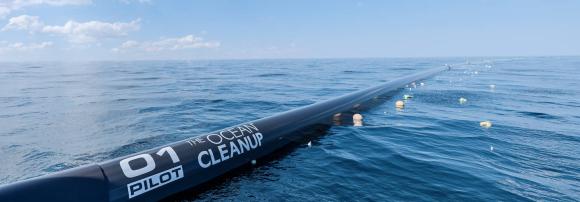 About five years ago, a 19-year-old Dutch engineering student, Boyan Slat, made a big splash, at least on the internet, when he unveiled his design of refuse collecting booms, which he claimed would clean the oceans of plastics within five years. He described an anchored network of floating booms and platforms which would skim plastics and other refuse being carried along any of the five ocean gyres.
About five years ago, a 19-year-old Dutch engineering student, Boyan Slat, made a big splash, at least on the internet, when he unveiled his design of refuse collecting booms, which he claimed would clean the oceans of plastics within five years. He described an anchored network of floating booms and platforms which would skim plastics and other refuse being carried along any of the five ocean gyres.
Now, Slat and his non-profit Ocean Cleanup are deploying a 600-meter-long prototype boom system to test the concept. The NY Times reports that the boom will be towed to a site where it will undergo two weeks of testing. If everything goes as planned, the boom will then be brought to the garbage patch, nearly 1,400 miles offshore, where it is expected to arrive by mid-October.
The 2,000-foot-long unmanned structure was the product of about $20 million in funding from Ocean Cleanup, a nonprofit. They hope to trap up to 68 metric tonnes of plastic during the boom’s first year at sea. The concept is to use the ocean winds and currents to passively collect and concentrate drifting plastics, which would then be collected by ships and carried to shore for disposal or recycling. The boom has an impenetrable skirt that hangs nearly 10 feet below to catch smaller pieces of plastic.
Over the last five years of development, the design has evolved. The original anchored boom network is now designed to drift. The goals have are also somewhat more limited. The organization now hopes to clean half of the Great Pacific Garbage Patch within five years, still a highly aggressive target.
There are concerns about the survivability of the booms in the harsh ocean environment, the cost of collecting and handling the plastics, and the potential impact on marine life.
The NY Times quotes George Leonard, chief scientist at the Ocean Conservancy, “There’s worry that you can’t remove the plastic without removing marine life at the same time. We know from the fishing industry if you put any sort of structure in the open ocean, it acts as a fish-aggregating device.”
“I think the big challenge here is not the long-term goal but the short-term goal,” Mr. Leonard said on Saturday. “Can it remove plastic at all?”
Others question whether the focus on removing plastic in the ocean is less effective than preventing plastics from reaching the oceans in the first place. Each year an estimated 8 million metric tons of plastic are dumped into the ocean. Scientific American notes that a recent study estimates that more than a quarter of all that waste could be pouring in from just 10 rivers, eight of them in Asia.
Ocean Cleanup Launched A Plastic Catcher | CNBC
Thanks to David Rye for contributing to this post.

How long before it gets broken by a ship, watchkeeping ain’t what it used to be – they’re all too busy playing computer games and calling it “doing office work”?
Wont clean the small stuff fish eat.
READ THIS:
Piling up: Drowning in
a sea of plastic –
CBS News
AUG 5, 2018 9:09 AM
EDT
https://www.cbsnews.com/news/piling-up-drowning-in-a-sea-of-plastic/
Hey guys! It is a start and from little acorns, giant oak trees grow.
Most of the stuff comes from the Far East but it impacts on the US ecosystem. Support it and then go back to the Far East and say “Hey! This is yours! Stop it! Otherwise President Trump will get angry and do something worthwhile!”
“A student may have found a solution to one of the world’s most urgent environmental crises – breeding bacteria capable of “eating” plastic and potentially breaking it down into harmless by-products.
The microbes degrade polyethylene terephthalate (PET) – one of the world’s most common plastics, used in clothing, drinks bottles and food packaging.”
Continues at – https://www.independent.co.uk/environment/plastic-eating-bacteria-pollution-crisis-environment-microbes-student-a8423146.html
I am sure that there is a more scientific article on the subject?
I hope the microbes don’t start eating bits of our boats!
Peter Wright: Most of the Far East plastic was sent there by the USA.
China wanted it, they bought it, but now they dont want it.